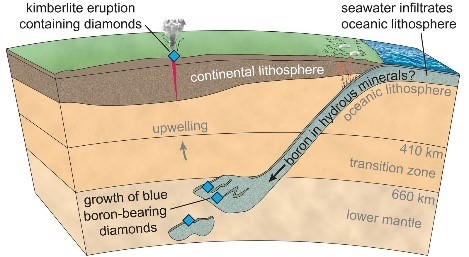New study finds blue boron-bearing diamonds on rock recycling route


Rough blue diamonds, weighing between 0.7 and 3 carats each. Examining rough samples can be a good opportunity to see inclusions, because inclusions are often skillfully cut and polished away to optimize the appearance of the faceted gem. Photo by Evan M. Smith, Gemological Institute of America
A study recently published in Nature by University of Cape Town (UCT) geologist, Professor Steve Richardson, and his international peers has revealed that blue diamonds are a ‘superdeep’ type of diamonds that originate as much as four times deeper in the Earth (up to 660–750 km) compared to most other diamonds.
The study, titled “Blue boron-bearing diamonds from Earth’s lower mantle” provides a new explanation for why blue diamonds are different from other kinds of diamonds. The answer comes down to the shifting and sinking of oceanic tectonic plates: Blue diamonds, they posit, grew in the presence of rocks that were essentially once a part of the ocean floor. According to the study, blue diamonds have a connection to deeply recycled seawater from ancient oceans.
Oceanic tectonic plates are pushed down into the mantle at subduction zones such as those found currently around the Pacific Ocean (the movement of the oceanic plates down into the Earth causes the earthquakes and volcanoes of the so-called Pacific Ring of Fire). The extent to which Earth’s surface materials are recycled into the deep mantle via these subduction zones has until now been difficult to evaluate. The study sheds light on the issue by examining blue diamonds. These rare gems get their colour from boron, an element predominantly found in the crust, close to the surface of the Earth. This suggests boron somehow made it all the way down to the super-deep high-pressure environment where these diamonds form.
Blue, boron-bearing diamonds (known to researchers as type IIb) like the famous Hope diamond have long been considered unusual, but exactly how or where they crystallize within the mantle has remained entirely unknown.
Professor Richardson said: “A couple of years ago we found that the world’s largest and most valuable gem diamonds like the 3 106-carat Cullinan formed from metallic liquid deep in the Earth’s mantle transition zone.”
That research was published in Science and showed that these enormous and irregularly shaped type IIa diamonds (so-named for the absence of nitrogen) stand out because they are so pure – and hence colourless – giving rise to the acronym CLIPPIR (Cullinan-like, Large, Inclusion-Poor, relatively Pure, Irregular shaped and Resorbed).
“We then speculated that blue diamonds, which also tend to be large, could be part of the same story as the CLIPPIR diamonds. They have boron in them, but no nitrogen either. This would mean that they might also be from very deep and the boron in them might be recycled boron because it's an element that's not very common in the mantle, whereas it's concentrated in the crust.”
Though Richardson's main teaching focus at UCT is on postgraduate isotope geology, he also teaches second-year undergraduate mineralogy.

Cross section showing the crystallization of blue boron-bearing diamonds in the lower mantle, linked to subducted oceanic lithosphere. It is proposed that the boron might have originally been sourced from the ocean. Photo by Evan M. Smith, Gemological Institute of America
“All these gemstones are versions of rock-forming minerals that we teach our students about. So, we thought the boron might be recycled back down in water-bearing minerals like serpentine, which could soak up boron from seawater. And now we have the physical evidence.”
The research team, led by Evan Smith of the Gemological Institute of America, examined small mineral grains, or inclusions, trapped inside blue diamonds during growth to decipher their birthplace. By studying 46 type IIb diamonds with inclusions, a consistent picture emerged. The inclusions represent high-pressure mineral phases that could only have been captured at least as deep as the mantle transition zone (410–660 km) or even deeper, perhaps at depths corresponding to the lower mantle (beyond 660 km).
In addition to the depth of origin, the inclusions show that the rocks in which the diamonds grew were part of oceanic tectonic plates, called oceanic lithosphere, that had sunken down to the lower mantle by subduction. This means that boron-bearing diamonds are crystallized at super-deep depths, in the presence of rocks that were once at the surface.

Blue boron-bearing diamond, containing mineral inclusions that were examined as part of this study. This gem is 6.08 carats, and 1.29cm wide. Photo by Jae Liao/Gemological Institute of America
This new study is further overturning the belief that superdeep diamonds are typically small and never of gem quality. Not only are type IIb diamonds among the deepest diamonds known, but we are also learning that boron and water can be carried from the ocean deep into the mantle by the process of subduction. This is a key observation for our understanding of mantle geochemistry and the vertical extent of plate tectonic processes.
